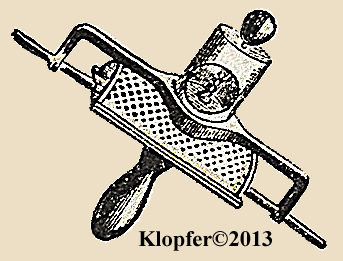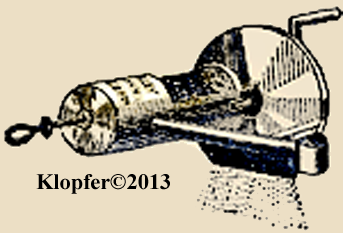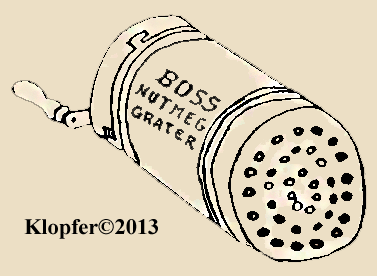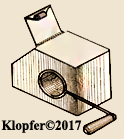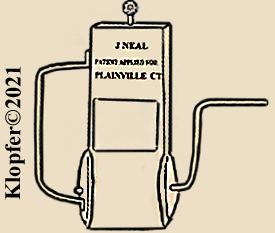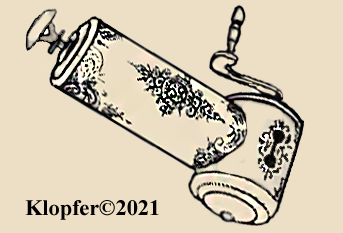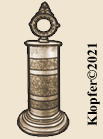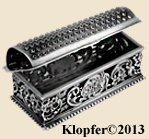 Click Me!
Click Me!
NutmegGraters.Com

- Home
- Featured Stories
- Picture Gallery
- Info.Wanted :
- Spurious Marks
- Trading Post
- Contact Our Site
- Wanted To Buy
[WELCOME: My articles published on NutmegGraters.Com and commercially (elsewhere) required many years of primary research, personal expense, travel and much effort to publish. This is provided for your enjoyment, it is required that if quoting my copyrighted text material, directly provide professionally appropriate references to me. Images are unavailable for copy. Thank you J. Klopfer.]
_______________________________________________________________________________________________________________________________________________________
Pioneers of Muskegon ~ William W. Owen & Daniel J. Kelly
In 1836, while still an untouched, old growth wilderness, Muskegon was first settled by Henry Penoyer, a lumber agent from Chicago. In the next year 1837, Theodore Newell built Muskegon's first house. A lumber boom followed and the population rapidly increased to 400 in 1853, jumping to 2000 by 1857. From a backcountry, Muskegon catapulted into a metropolis ~ it was plotted in 1853, incorporated as a village in 1861, and became a city in 1870. A population of 2200 in 1865 doubled to 5000 in 1867 and redoubled to 11,000 in 1875.
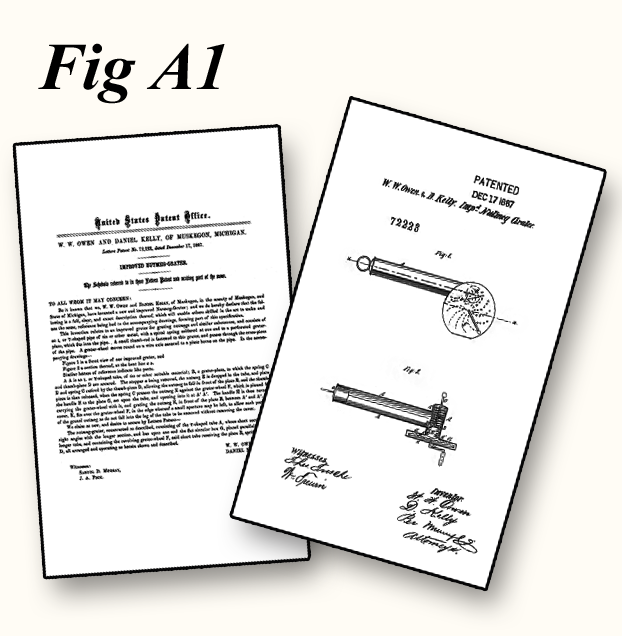
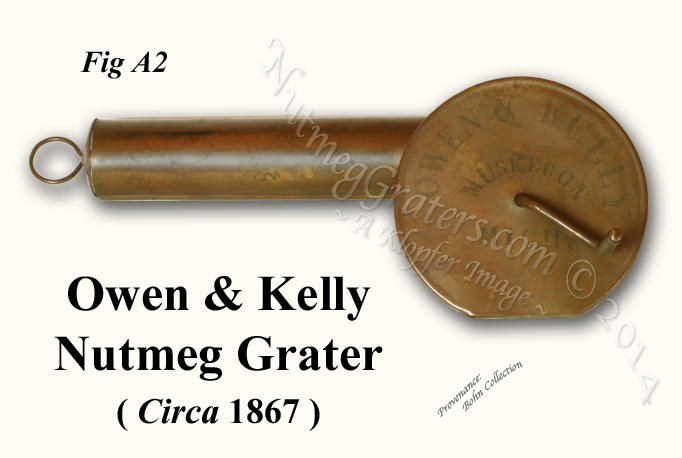 Our nutmeg grater story begins about 1867, a few years after the arrivals of William W. Owen (1840-1899), who at age 19 came to Muskegon in 1859 and Daniel J. Kelly (1833-1903), who at age 32, appeared in 1865. These two town-fathers soon intertwine in a brief business venture. While no documents exist pertaining to the nutmeg grater's actual manufacture or distribution ~ an Owen & Kelly patent # 72223 for an "Improved Nutmeg-Grater" was issued on Tuesday, December 17, 1867 (Fig A1). Experienced in merchandizing a general store, we surmise "Billy" Owen was the primary inventor of the nutmeg grater, and as owner of a planing mill, Daniel Kelly provided the manufacturing site. Witnesses listed on the patent were Muskegon locals: John A. Peck was a co-worker with "Billy" and Samuel D. Murray operated a confectionery-restaurant near Owen's place of work. The nutmeg grater (Fig A2) is fabricated from sheet copper, and embossed across the wheel-house case, it reads: "Owen & Kelly" "Muskegon" "Mich.". In construction, the grater conforms exactly with its patent specifications. The Owen & Kelly patent is sited in Scientific America among a lengthy listing of newly patented inventions, but no other advertisement, promotion or sales record is known. Based on its rarity among public and private collections, it is conclusive that this nutmeg grater was in production for a very brief period. The Owen & Kelly nutmeg grater is very scarce.
Our nutmeg grater story begins about 1867, a few years after the arrivals of William W. Owen (1840-1899), who at age 19 came to Muskegon in 1859 and Daniel J. Kelly (1833-1903), who at age 32, appeared in 1865. These two town-fathers soon intertwine in a brief business venture. While no documents exist pertaining to the nutmeg grater's actual manufacture or distribution ~ an Owen & Kelly patent # 72223 for an "Improved Nutmeg-Grater" was issued on Tuesday, December 17, 1867 (Fig A1). Experienced in merchandizing a general store, we surmise "Billy" Owen was the primary inventor of the nutmeg grater, and as owner of a planing mill, Daniel Kelly provided the manufacturing site. Witnesses listed on the patent were Muskegon locals: John A. Peck was a co-worker with "Billy" and Samuel D. Murray operated a confectionery-restaurant near Owen's place of work. The nutmeg grater (Fig A2) is fabricated from sheet copper, and embossed across the wheel-house case, it reads: "Owen & Kelly" "Muskegon" "Mich.". In construction, the grater conforms exactly with its patent specifications. The Owen & Kelly patent is sited in Scientific America among a lengthy listing of newly patented inventions, but no other advertisement, promotion or sales record is known. Based on its rarity among public and private collections, it is conclusive that this nutmeg grater was in production for a very brief period. The Owen & Kelly nutmeg grater is very scarce.
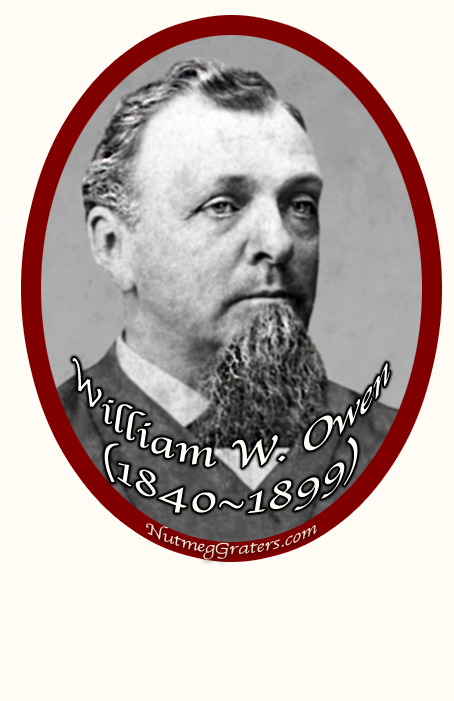 A Snapshot: William W. Owen
A Snapshot: William W. Owen
 "Billy" Owen was born in Sussex County, New Jersey on August 15, 1840; his father died when he was only 5. At age 15 in 1855, he relocated with his mother to Pontiac, Oakland County, Michigan. Across the state in Muskegon, early in 1859, Samuel B. Peck opened a general store on Western Avenue and that September, William arrives, recruited as a clerk. Soon, William accepted an additional clerking position at the local post office under C. P. Bigelow. Although William attempted in 1861 to enlist in the war effort, he was not mustered in, being refused by the board at Grand Rapids. In 1863, William marries Armina E. Boyce who was a native from Upper Canada. They had three children, but all pre-decease their parents during childhood. On January 30, 1865, William Owen is locally appointed the Postmaster of Muskegon, receiving a Presidentially nomination to this post on April 1, 1867 followed by a U.S. Senate confirmation. In this office, he is the first in Muskegon to issue a postal money order. William continued this office until March 26, 1869.
"Billy" Owen was born in Sussex County, New Jersey on August 15, 1840; his father died when he was only 5. At age 15 in 1855, he relocated with his mother to Pontiac, Oakland County, Michigan. Across the state in Muskegon, early in 1859, Samuel B. Peck opened a general store on Western Avenue and that September, William arrives, recruited as a clerk. Soon, William accepted an additional clerking position at the local post office under C. P. Bigelow. Although William attempted in 1861 to enlist in the war effort, he was not mustered in, being refused by the board at Grand Rapids. In 1863, William marries Armina E. Boyce who was a native from Upper Canada. They had three children, but all pre-decease their parents during childhood. On January 30, 1865, William Owen is locally appointed the Postmaster of Muskegon, receiving a Presidentially nomination to this post on April 1, 1867 followed by a U.S. Senate confirmation. In this office, he is the first in Muskegon to issue a postal money order. William continued this office until March 26, 1869.
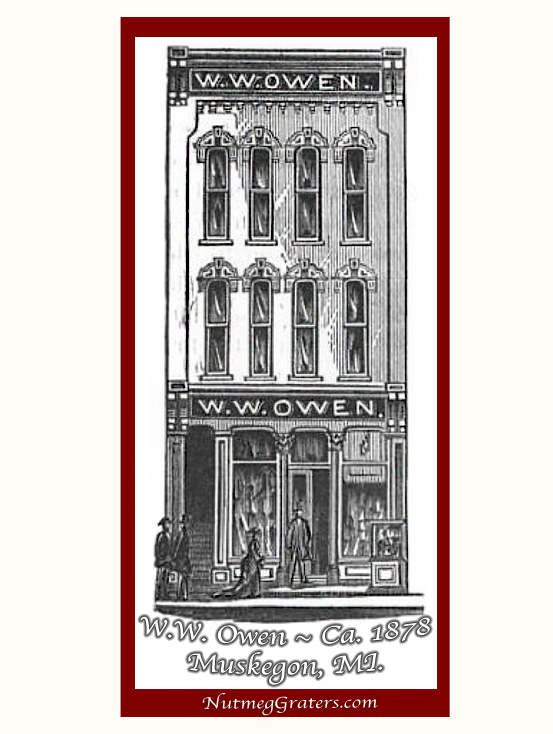 About 1865, William initiates his own business on Western Avenue and advertises sewing machines for sale. After the "Great Fire of 1874" destroyed Muskegon's business district, William Owen rebuilt a "business block". He erected the city's first brick and stone building in 1878. This "substantial brick block" building measured 85 feet deep with a 22 foot frontage on Western Avenue and received much public acclaim.
About 1865, William initiates his own business on Western Avenue and advertises sewing machines for sale. After the "Great Fire of 1874" destroyed Muskegon's business district, William Owen rebuilt a "business block". He erected the city's first brick and stone building in 1878. This "substantial brick block" building measured 85 feet deep with a 22 foot frontage on Western Avenue and received much public acclaim.
When Muskegon bookseller Mr. Snyder retired, William purchased his stock, thus adding the newspaper and book trade to his earlier business endeavors: being Singer sewing machines; music, pianos, organs, and musical instruments; and real-estate. By 1879, he also becomes the local ticket agent for the C. & W. M. R.R. and general R.R. ticket office at the Post Office. William sold out his "stationery and book store" in 1886, focused instead on his real-estate and insurance interests. This same year he was elected as a Muskegon supervisor, where he was quickly voted chairman by the board of supervisors. He unsuccessfully ran for the City Assessor in 1890.
William Owen was a "jack-of-all" trades. Throughout his life, "Billy" Owen served on a multitude of town committees and boards. He was dedicated to advancing the quality of living for Muskegon's inhabitants. At age 59, after living more than 25 years at his residence on South Terrace Street, William Owen died on August 2, 1899.
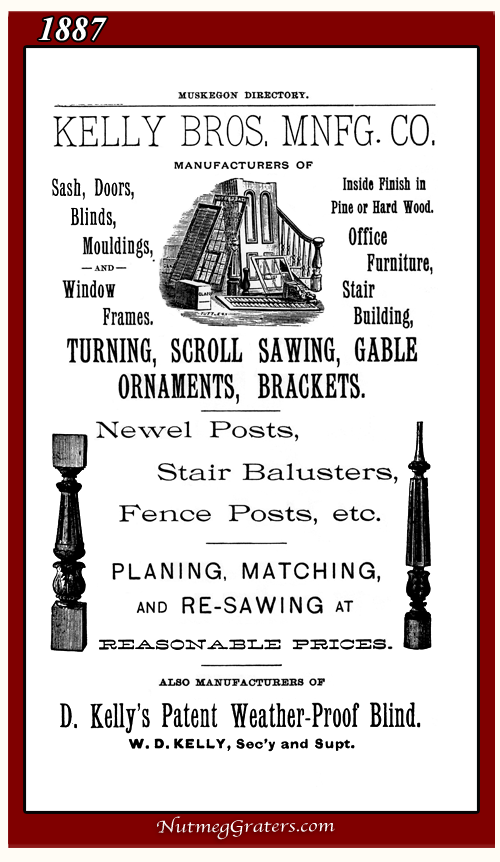 A Snapshot: Daniel J. & William D. Kelly
A Snapshot: Daniel J. & William D. Kelly
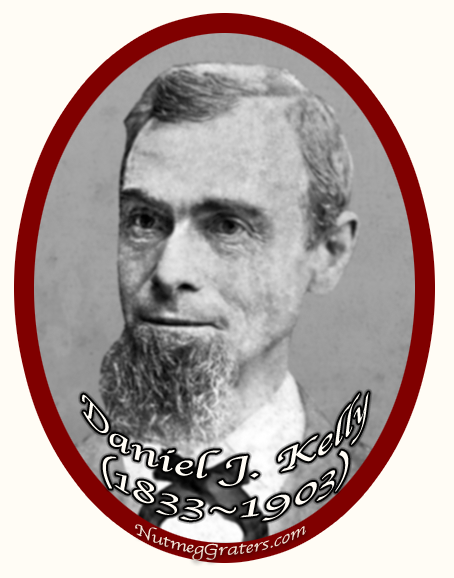
 Daniel J. Kelly (1833-1903) was born in New York City on June 16, 1833 after his parents immigrated from Ireland in 1832. An industrious teenager, Daniel engaged in a broad spectrum of employment during his youth. First he worked in a carriage shop in Newark, NJ, before taking a position at Barnum's Crystal Palace in New York City. Next, he took an apprenticeship at a sash and blind makers factory in Middletown, Orange County, NJ, followed by employment in a sash and blind business located in Newark, NJ. In 1854 at age 21, his parents relocate to a farm in Cascade, MI, giving Daniel an opportunity to partner with his younger brother John by starting their own large sash and blind shop in nearby Grand Rapids. About 1857, he married Mary {.......} (1836~1930) and they had 13 children.
Daniel J. Kelly (1833-1903) was born in New York City on June 16, 1833 after his parents immigrated from Ireland in 1832. An industrious teenager, Daniel engaged in a broad spectrum of employment during his youth. First he worked in a carriage shop in Newark, NJ, before taking a position at Barnum's Crystal Palace in New York City. Next, he took an apprenticeship at a sash and blind makers factory in Middletown, Orange County, NJ, followed by employment in a sash and blind business located in Newark, NJ. In 1854 at age 21, his parents relocate to a farm in Cascade, MI, giving Daniel an opportunity to partner with his younger brother John by starting their own large sash and blind shop in nearby Grand Rapids. About 1857, he married Mary {.......} (1836~1930) and they had 13 children.
Daniel moved to Muskegon in 1865 where, in partnership with Patrick Ducey and James Cavanaugh, he constructs D. Kelly & Co., a planing mill on Clay Avenue, near Ryerson Creek. In 1868, they erect a new mill on First Street, fronting on Morris Street. In the early 1870's Mr. Ducey sells out his interest and Mr. Cavanaugh retires. Daniel becomes sole owner and apprentices his sons in the business. William D. Kelly, the oldest son, eventually takes over for his father, becoming primary manager of the family's business interests.
When Muskegon's city fire department was first assembled in 1868, Daniel began a long term association within the organization. He was the engineer of an old pioneer steam fire engine, the first Silsby rotary engine procured by the city.
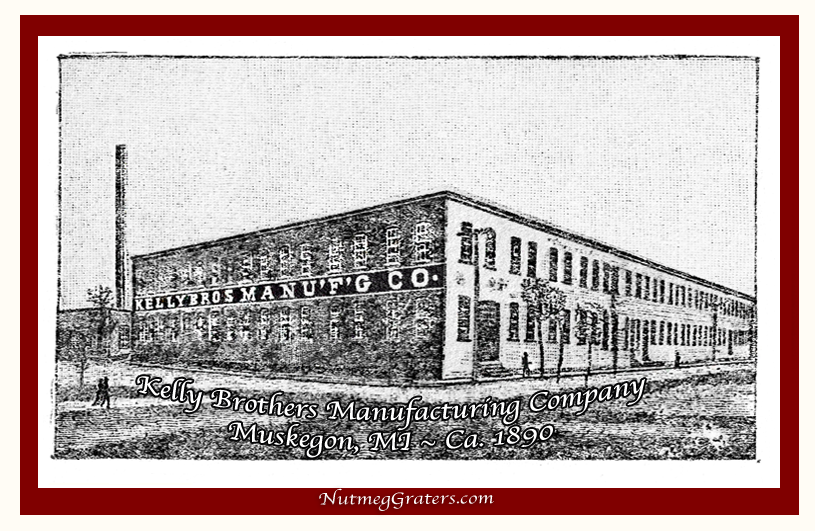 In 1876, D. Kelly & Co. advertises the manufacture of door sashes and Kelly's patent blinds. This same year, the Kelly's venture into the steamboat business. With his sons, they first build a vessel named Susie Watson and then a second ship named the Kelly Bros. The later boat was employed in the ferry business between North Muskegon and Muskegon and also towed logs. Daniel was known to regularly pilot these vessels. The boat Kelly Bros. was sold in Chicago about 1882.
In 1876, D. Kelly & Co. advertises the manufacture of door sashes and Kelly's patent blinds. This same year, the Kelly's venture into the steamboat business. With his sons, they first build a vessel named Susie Watson and then a second ship named the Kelly Bros. The later boat was employed in the ferry business between North Muskegon and Muskegon and also towed logs. Daniel was known to regularly pilot these vessels. The boat Kelly Bros. was sold in Chicago about 1882.
The Kelly Bros. Manufacturing Company was incorporated in May 1883, and from its inception through 1896, Daniel Kelly was listed as the firm's president. Although he retained a financial interest in the firm, this business was established and managed by his sons. His oldest son Daniel W. Kelly remained the company's superintendent, and directed the manufacture of architectural wooden products. During this period, Daniel Kelly and his sons obtained several U.S. Patents. Originally, the firm employed 25 to 35 workers, but in 1891 the business transitioned into a larger, new facility at Muskegon Heights, where they employed over 125 people. In 1898, Kelly Bros. Manf. Co. relocated to Chicago, moving nearer their primary buyers in the Midwest. Daniel Kelly remains behind in Muskegon.
At the age of 68, Daniel's health began to fail and after two years, Daniel leaves Muskegon in the Spring of 1903 to join his family in Chicago. Daniel Kelly died October 7, 1903.
[KLOPFER article © September 2014]
